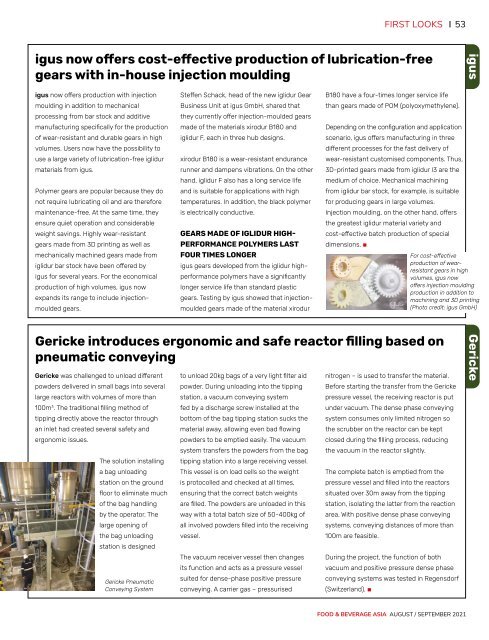Food & Beverage Asia August/September 2021
Food & Beverage Asia (FBA) is the leading source of food and beverage news in Asia since 2002. FBA delivers a comprehensive view of the food and beverage landscape, spanning across the latest health and nutrition trends and industry innovations in ingredients, recipe formulations, food science, sustainability, packaging, and automation, as well as advancements in agri and food-tech.
Food & Beverage Asia (FBA) is the leading source of food and beverage news in Asia since 2002. FBA delivers a comprehensive view of the food and beverage landscape, spanning across the latest health and nutrition trends and industry innovations in ingredients, recipe formulations, food science, sustainability, packaging, and automation, as well as advancements in agri and food-tech.
Create successful ePaper yourself
Turn your PDF publications into a flip-book with our unique Google optimized e-Paper software.
FIRST LOOKS 53<br />
igus now offers cost-effective production of lubrication-free<br />
gears with in-house injection moulding<br />
igus now offers production with injection<br />
moulding in addition to mechanical<br />
processing from bar stock and additive<br />
manufacturing specifically for the production<br />
of wear-resistant and durable gears in high<br />
volumes. Users now have the possibility to<br />
use a large variety of lubrication-free iglidur<br />
materials from igus.<br />
Polymer gears are popular because they do<br />
not require lubricating oil and are therefore<br />
maintenance-free. At the same time, they<br />
ensure quiet operation and considerable<br />
weight savings. Highly wear-resistant<br />
gears made from 3D printing as well as<br />
mechanically machined gears made from<br />
iglidur bar stock have been offered by<br />
igus for several years. For the economical<br />
production of high volumes, igus now<br />
expands its range to include injectionmoulded<br />
gears.<br />
Gericke introduces ergonomic and safe reactor filling based on<br />
pneumatic conveying<br />
Gericke was challenged to unload different<br />
powders delivered in small bags into several<br />
large reactors with volumes of more than<br />
100m 3 . The traditional filling method of<br />
tipping directly above the reactor through<br />
an inlet had created several safety and<br />
ergonomic issues.<br />
The solution installing<br />
a bag unloading<br />
station on the ground<br />
floor to eliminate much<br />
of the bag handling<br />
by the operator. The<br />
large opening of<br />
the bag unloading<br />
station is designed<br />
Gericke Pneumatic<br />
Conveying System<br />
Steffen Schack, head of the new iglidur Gear<br />
Business Unit at igus GmbH, shared that<br />
they currently offer injection-moulded gears<br />
made of the materials xirodur B180 and<br />
iglidur F, each in three hub designs.<br />
xirodur B180 is a wear-resistant endurance<br />
runner and dampens vibrations. On the other<br />
hand, iglidur F also has a long service life<br />
and is suitable for applications with high<br />
temperatures. In addition, the black polymer<br />
is electrically conductive.<br />
GEARS MADE OF IGLIDUR HIGH-<br />
PERFORMANCE POLYMERS LAST<br />
FOUR TIMES LONGER<br />
igus gears developed from the iglidur highperformance<br />
polymers have a significantly<br />
longer service life than standard plastic<br />
gears. Testing by igus showed that injectionmoulded<br />
gears made of the material xirodur<br />
to unload 20kg bags of a very light filter aid<br />
powder. During unloading into the tipping<br />
station, a vacuum conveying system<br />
fed by a discharge screw installed at the<br />
bottom of the bag tipping station sucks the<br />
material away, allowing even bad flowing<br />
powders to be emptied easily. The vacuum<br />
system transfers the powders from the bag<br />
tipping station into a large receiving vessel.<br />
This vessel is on load cells so the weight<br />
is protocolled and checked at all times,<br />
ensuring that the correct batch weights<br />
are filled. The powders are unloaded in this<br />
way with a total batch size of 50-400kg of<br />
all involved powders filled into the receiving<br />
vessel.<br />
The vacuum receiver vessel then changes<br />
its function and acts as a pressure vessel<br />
suited for dense-phase positive pressure<br />
conveying. A carrier gas – pressurised<br />
B180 have a four-times longer service life<br />
than gears made of POM (polyoxymethylene).<br />
Depending on the configuration and application<br />
scenario, igus offers manufacturing in three<br />
different processes for the fast delivery of<br />
wear-resistant customised components. Thus,<br />
3D-printed gears made from iglidur I3 are the<br />
medium of choice. Mechanical machining<br />
from iglidur bar stock, for example, is suitable<br />
for producing gears in large volumes.<br />
Injection moulding, on the other hand, offers<br />
the greatest iglidur material variety and<br />
cost-effective batch production of special<br />
dimensions. ■<br />
igus Gericke<br />
For cost-effective<br />
production of wearresistant<br />
gears in high<br />
volumes, igus now<br />
offers injection moulding<br />
production in addition to<br />
machining and 3D printing<br />
(Photo credit: igus GmbH)<br />
nitrogen – is used to transfer the material.<br />
Before starting the transfer from the Gericke<br />
pressure vessel, the receiving reactor is put<br />
under vacuum. The dense phase conveying<br />
system consumes only limited nitrogen so<br />
the scrubber on the reactor can be kept<br />
closed during the filling process, reducing<br />
the vacuum in the reactor slightly.<br />
The complete batch is emptied from the<br />
pressure vessel and filled into the reactors<br />
situated over 30m away from the tipping<br />
station, isolating the latter from the reaction<br />
area. With positive dense phase conveying<br />
systems, conveying distances of more than<br />
100m are feasible.<br />
During the project, the function of both<br />
vacuum and positive pressure dense phase<br />
conveying systems was tested in Regensdorf<br />
(Switzerland). ■<br />
FOOD & BEVERAGE ASIA AUGUST / SEPTEMBER <strong>2021</strong>


















